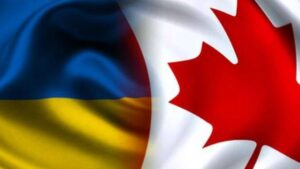
Ukraine ranks seventh in the world in terms of Internet traffic.
“Ukraine is actively developing traffic exchange points. For four years now, the country has ranked seventh and is ahead of many other states that are much larger than Ukraine,” Bill Woodcock, Executive Director of Packet Clearing House (PCH), said at the UADOM conference in Kyiv on Thursday .
He also noted that PCH has been cooperating with the UA domain registry by Hostmaster since 2004.
“During this time, best security practices have been introduced in the Ukrainian domain, and now Ukraine is among the 25 most developed countries in the world that use the most advanced security technologies,” the PCH executive director emphasized.
Packet Clearing House is an international non-profit organization responsible for providing operational support and security for critical Internet infrastructure, including Internet data exchange points and the core of the Domain Name System.
The “.UA” domain was delegated by the international organization IANA (later renamed ICANN) to Dmitry Kokhmanyuk and Igor Sviridov in 1992 in the interests of the entire Ukrainian Internet community. For a long time, the administration and development of the domain on a voluntary basis was carried out by specialists who united the Ukrainian Network Coordination Group (UA NCG) and created in 2001 a specialized enterprise Hostmaster LLC, which currently performs the functions of an administrator.

US Permanent Representative to the UN Linda Thomas-Greenfield has arrived in Ukraine on a visit, said Nate Evans, Director of Communications and Press Secretary of the US Mission to the UN.
“The US Ambassador to the UN is in Kyiv for a day of meetings to reaffirm the unwavering US support for Ukraine as it defends its freedom and sovereignty in the face of Russia’s brutal and unprovoked invasion,” Evans tweeted on Tuesday.
While in Kyiv, Thomas-Greenfield will meet with Ukrainian government leaders to discuss the unwavering US commitment to Ukraine’s sovereignty and independence, according to the US Embassy in Ukraine. She will oversee efforts to document and preserve evidence of atrocities committed by Russian forces and hear first-hand accounts from survivors.
Ambassador Thomas-Greenfield will also discuss the global food security crisis exacerbated by Russia’s invasion and stress the urgent need to extend the Black Sea Grain Initiative into next year. She will also meet with humanitarian organizations working to meet the winterization needs of vulnerable populations affected by Russian attacks on energy and other civilian infrastructure.

More than EUR66 million will be allocated under the first Interreg NEXT European cross-border cooperation program for Hungary, Slovakia and Romania’s partnership with Ukraine in health, environment and good governance, the European Commission (EC) announced Friday. “This program is part of the EU’s overall support and unwavering solidarity toward Ukraine. By implementing a cohesion policy, Interreg will help Ukraine and its bordering member states to face common challenges and seize joint opportunities,” said Elisa Ferreira, EC member for cohesion policy and reforms.
The program covers the period of 2021-2027. Hungary, Slovakia, Romania and Ukraine are expected to work together to ensure equal access to health services and improve the sustainability of their health systems.
The program will support climate change adaptation and disaster risk prevention solutions. The participating countries will cooperate to protect nature, develop “green infrastructure” and tourism.
It is also a question of aligning Ukraine’s norms with EU member states in the area of effective public administration. Relevant projects will promote legal and administrative cooperation to remove common barriers to interaction in border areas, while supporting cooperation between citizens, civil societies and state institutions, according to a communiqué from the European Commission.
CROSS-BORDER COOPERATION, HUNGARY, ROMANIA, SLOVAKIA, UKRAINE

The Cabinet of Ministers offers the Verkhovna Rada to ratify the framework agreement between the governments of Ukraine and Austria on economic cooperation in the development of projects.
As the representative of the Cabinet of Ministers in the Verkhovna Rada Taras Melnychuk said in Telegram on Friday, the corresponding decision was made at a government meeting on Friday.
Approved, in particular, the draft law “On the ratification of the framework agreement between the government of Ukraine and the government of the Republic of Austria on economic cooperation in the development of projects.”
It is noted that the ratification of the framework agreement will create a legal basis for economic cooperation between countries in the development of priority projects, in particular, for the construction (reconstruction) and equipping of the National Children’s Specialized Hospital “Okhmatdet” in Kyiv, the construction and equipping of a clinic in Kyiv, the creation of a National Rehabilitation Center in Lvov.

During a telephone conversation with Ukrainian President Volodymyr Zelensky on Tuesday, French President Emmanuel Macron agreed to hold an international conference on assistance to Ukraine in the coming winter in Paris on December 13, the Elysee Palace said on Tuesday.
“The President of the Republic (…) expressed his determination to help Ukraine weather the approach of winter (…). He indicated that France would increase its support in this regard and take part in international mobilization (aid). The two presidents agreed to organize on December 13 in Paris an international conference in support of the civil resilience of the country during the winter period,” the presidential office said in a communiqué.
We are talking, in particular, about the restoration of infrastructure, electricity and water supply.
The document says that for this “preparatory work with other partners of Ukraine will begin in the near future.”
In addition, according to the communiqué, Macron and Zelensky also agreed on the organization of a bilateral conference aimed at helping Ukraine from French enterprises, which will be held on December 12.

The Government of Canada will issue five-year bonds – Ukraine Sovereignty Bonds – to financially support Ukraine, Prime Minister Justin Trudeau said at the XXVII Triennial Congress of Ukrainian Canadians in Winnipeg on Friday.
“Canada remains unwavering in our commitment to support the people of Ukraine in their fight against Putin’s illegal and barbaric invasion, and we will continue to do everything we can to ensure Ukraine has the resources it needs to win. Now, through a bond designated for Ukraine, Canadians can contribute to this critical effort through a new federally backed investment,” Deputy Prime Minister and Finance Minister Chrystia Freeland said in a statement on the Prime Minister’s website.
Trudeau announced that the Government of Canada will issue Ukraine Sovereignty Bonds, which will help the government continue operations, including providing essential services to Ukrainians, like pensions, and purchasing fuel before winter.
The equivalent proceeds from this five-year bond will be channelled directly to Ukraine through the International Monetary Fund’s (IMF) Administered Account. This builds on the Government of Canada’s CAD 2 billion in financial assistance to Ukraine this year, the report said.
According to it, the new bonds will be offered by the participating financial institutions at denominations and rates to be announced shortly.
Those who decide to invest in this bond will actually purchase a regular five-year Canadian government bond backed by Canada’s AAA credit rating. Canada is the first country in the world outside of Ukraine to offer bonds in support of Ukraine for purchase.
To increase pressure on Putin’s regime, Trudeau also announced that Canada is imposing new sanctions on individuals and entities complicit in Russia’s invasion of Ukraine. These new measures will target 35 senior officials of energy entities, including those of Gazprom and its subsidiaries, and six energy sector entities involved in Russia’s ongoing violations of Ukraine’s sovereignty and territorial integrity. “These new measures build on the sanctions we have already implemented against over 1,400 individuals and entities,” he said.
He also announced that Canada intends to impose new sanctions on members of the Russian justice and security sectors, including police officers and investigators, prosecutors, judges, and prison officials, involved in gross and systematic human rights violations against Russian opposition leaders.
Trudeau said that the 39 armoured combat support vehicles (ACSVs) Canada announced for Ukraine in June have started to arrive in Europe, where training for the Ukrainian forces is underway, with the last expected to be delivered end of November. Since February 2022, Canada has committed over CAD 600 million in military assistance to Ukraine. Canada will continue to help Ukraine meet its urgent requirements for military and defence equipment.
The prime minister also said that Canada is allocating $55 million in previously announced funding to the International Federation of Red Cross and Red Crescent Societies, the International Organization for Migration, and the United Nations High Commissioner for Refugees and other humanitarian partners to support winterization initiatives. This includes providing shelter and distributing essential items such as blankets, clothing, heating appliances, and fuel.
In addition, the Prime Minister announced the launch of the Canada-Ukraine Science Partnership, which will invite up to 20 Ukraine-based scientists to come work and live in Canada.
According to the report, streamlining current visa and travel requirements, as of October 18, 2022, close to 315,000 applications have been approved.